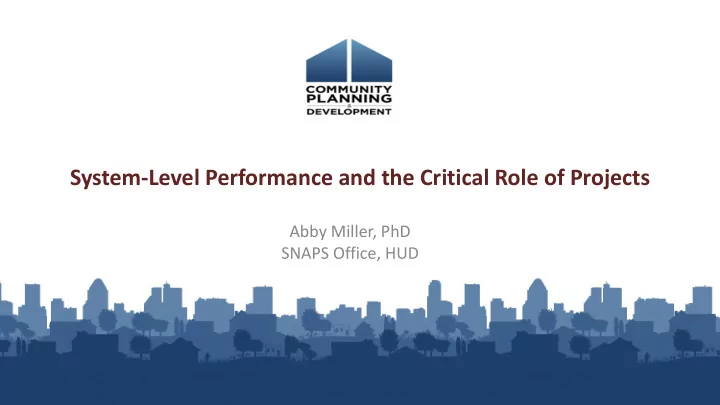

System-Level Performance and the Critical Role of Projects Abby Miller, PhD SNAPS Office, HUD
Why Measure System-level Performance? • It’s required… • But it also makes sense, with a lot of benefits: • Promotes strategic planning • Promotes common goals • Focuses on overall impact on people • Fosters coordination and accountability 2
Critical role of project performance Project Project System Does this project Is this project serve highly using best vulnerable practices? people? 3
Critical role of project performance: WNY Example 4
CoCs and Projects Work Together • CoC systematically generates reports for each System Performance Measure by subpopulation and by project type, looking at data quality as well. • Projects look at their own data and data quality. CoC and project discuss data to understand project or subpopulation characteristics that may affect performance • CoC analyzes data to determine impact on system performance (ex. 400 day average LOTH in a 10 bed Safe Haven project will not have the same impact as 90 day average LOTH in a 100 bed emergency shelter project) • Projects work to improve their program model, staffing, and data quality to contribute to system performance and ensure that they perform competitively • CoCs determine the right amount of resources to meet the need and make determinations about which projects are underperforming
System Performance and CoC Competition Why are CoCs worried about performance? • Competition is increasingly competitive between CoCs • More points dedicated to performance-related questions • Reallocation plays a big role • When CoCs perform poorly, funding for projects is lost
What you can do proactively • Begin to set local targets that take into account: – The nature of the local homeless population (e.g., prevalence of youth, or CH) – Subsystems – e.g., family shelter system – Local priorities as CoCs implement system change – Other unique local circumstances Set different goals for: For example: • different ‘sub - systems’ or project types of the system • Increase emergency shelter diversions to 20% (e.g., homelessness prevention, homeless outreach, men’s emergency shelter) • Reduce length of time homeless to 30 days and/or • • Reduce returns to homelessness to 5% projects that serve certain types of clients (e.g., different goals for projects serving severely disabled persons)
WNY Performance 8
WNY Performance 9
Setting Multi-Year Targets CoC Performance Targets by Project Type System Goal: reduce average length of time homeless to 30 days by end of 2017 Emergency Shelter Street Transitional Overall Outreach Housing System TA Youth Single Adults Families (18-24) Current 51 days 33 days 42 days 29 days 115 days 45 Performance 2017 Target 48 days 30 days 40 days 28 days 105 days 40 2018 Target 44 days 28 days 35 days 28 days 100 days 35 2019 Target 38 days 25 days 30 days 27 days 95 days 30
HUD System Performance Measures Page HUD System Performance Measures page on the HUD Exchange: https://www.hudexchange.info/coc/guides/system-performance-measures 11
Recommend
More recommend